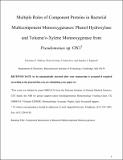Multiple Roles of Component Proteins in Bacterial Multicomponent Monooxygenases: Phenol Hydroxylase and Toluene/o-Xylene Monooxygenase from Pseudomonas sp. OX1
Author(s)
Tinberg, Christine E.; Song, Woon Ju; Izzo, Viviana A.; Lippard, Stephen J.
DownloadTinberg et al Biochemistry.pdf (969.4Kb)
PUBLISHER_POLICY
Publisher Policy
Article is made available in accordance with the publisher's policy and may be subject to US copyright law. Please refer to the publisher's site for terms of use.
Terms of use
Metadata
Show full item recordAbstract
Phenol hydroxylase (PH) and toluene/o-xylene monooxygenase (ToMO) from Pseudomonas sp. OX1 require three or four protein components to activate dioxygen for the oxidation of aromatic substrates at a carboxylate-bridged diiron center. In this study, we investigated the influence of the hydroxylases, regulatory proteins, and electron-transfer components of these systems on substrate (phenol; NADH) consumption and product (catechol; H2O2) generation. Single-turnover experiments revealed that only complete systems containing all three or four protein components are capable of oxidizing phenol, a major substrate for both enzymes. Under ideal conditions, the hydroxylated product yield was 50% of the diiron centers for both systems, suggesting that these enzymes operate by half-sites reactivity mechanisms. Single-turnover studies indicated that the PH and ToMO electron-transfer components exert regulatory effects on substrate oxidation processes taking place at the hydroxylase actives sites, most likely through allostery. Steady state NADH consumption assays showed that the regulatory proteins facilitate the electron-transfer step in the hydrocarbon oxidation cycle in the absence of phenol. Under these conditions, electron consumption is coupled to H2O2 formation in a hydroxylase-dependent manner. Mechanistic implications of these results are discussed.
Date issued
2011-03Department
Massachusetts Institute of Technology. Department of ChemistryJournal
Biochemistry
Publisher
American Chemical Society
Citation
Tinberg, Christine E. et al. “Multiple Roles of Component Proteins in Bacterial Multicomponent Monooxygenases: Phenol Hydroxylase and Toluene/o-Xylene Monooxygenase from Pseudomonas Sp. OX1.” Biochemistry (2011): 110302084620077.
Version: Author's final manuscript
ISSN
0006-2960
1520-4995